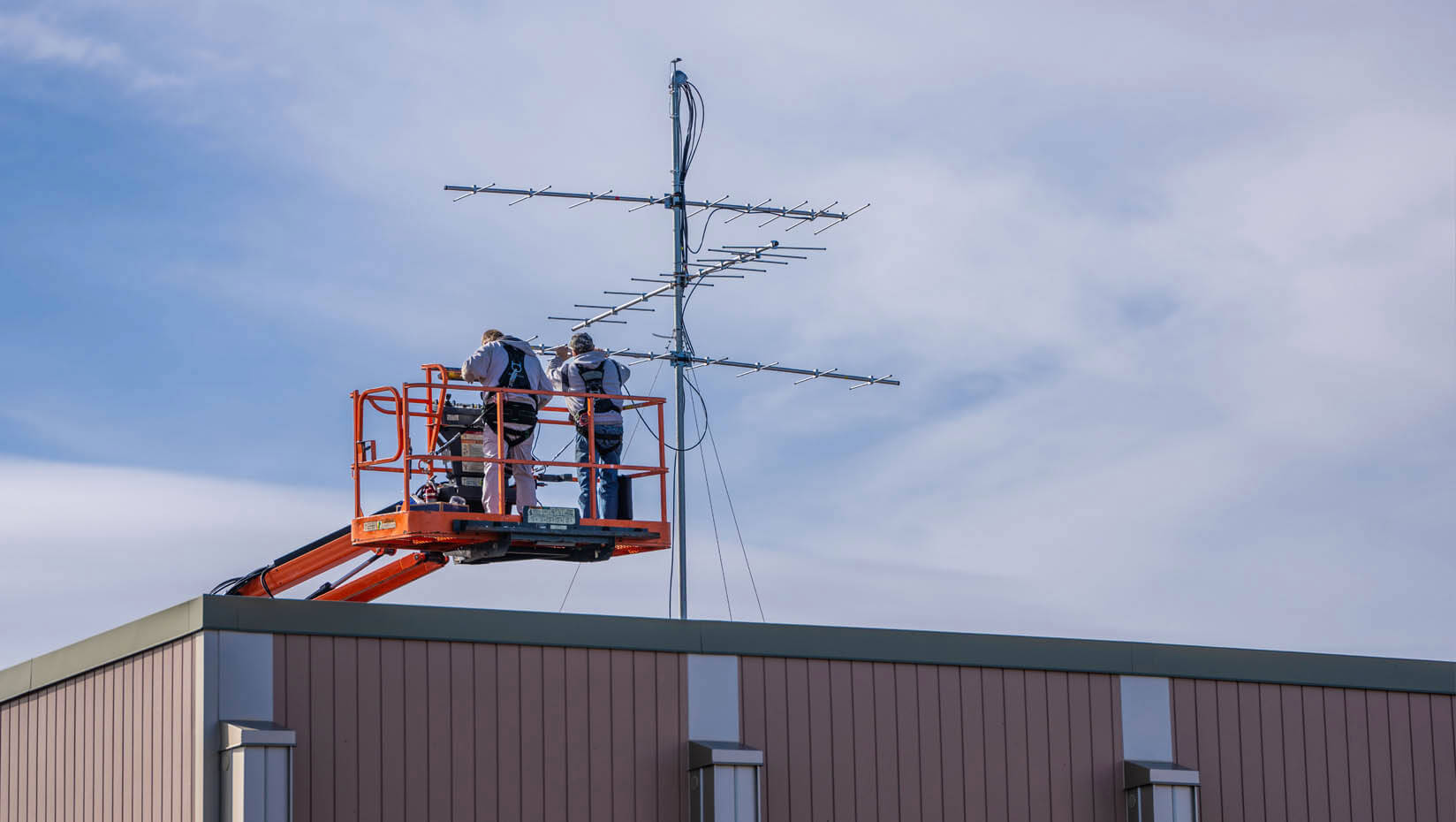
UMaine installs Motus receiving station on Nutting Hall to track migratory species
The Motus Wildlife Tracking System, or Motus for short, is an international collaborative research network that uses radio receiving stations to track tagged animals as they travel along their migratory paths. The network has more than 1,200 receiving stations in 31 countries — and now, one of them is at the University of Maine.
Oct. 5, UMaine finished installing the antennas for its Motus receiving station on the roof of Nutting Hall, thanks to funding from a UMaine Art Initiative Seed Grant. The apparatus will not only provide more research opportunities for UMaine students, but will also help bolster international efforts to track migratory species.
With Motus, flying animals — as big as birds and bats and small as butterflies and dragonflies — are tagged with a transmitter called a NanoTag. For birds, the transmitter is attached with a harness that wraps around their legs, with a weak point made from a rubber band that biodegrades in a year. NanoTags are glued directly (but delicately) onto larger insects such as monarch butterflies.
When the animal flies within about 15 kilometers of a Motus receiving station, the antenna will pick up the NanoTag’s radio signal and its location will be recorded. As the animal continues its journey and pings Motus stations along the way, researchers are able to map out its migratory pattern and compare it to other tagged animals in that species.
The new Motus receiving station at UMaine will add to the density of stations in the area, with the next nearest stations at Fields Pond Audubon Center and Hirundo Wildlife Refuge. Amber Roth, assistant professor of forest wildlife management, said that a number of factors can make it more difficult for stations to pick up on passing animals, from cloudy weather to obstruction from trees (or even the occasional false detection due to other radio interference). A cluster of stations in a heavily forested area like Maine improves NanoTag detections and the quality of the data.
“That’s something we’re working on in the Northeast, to increase the number of stations so we have more detections of animals passing through,” Roth says.
Roth has been using Motus data since around 2019 for her research about birds, like her project studying the health and habitat of the Bicknell’s thrush and the rusty blackbird, two species of migratory songbirds whose populations are declining and are the focus of conservation efforts. For this research, UMaine managed a Motus station in the mountains of western Maine, but the receiving station required a fair amount of upkeep that made the remote station difficult to manage.
“It’s a tall mast with 10-foot-long antennas attached. If you have a station that’s not on a power source you have to have solar panels and giant batteries that weigh around 70 pounds. Imagine working on a high mountain where the only access is a trail and you have to tote this stuff over a mile straight uphill. Then you have to dismantle everything every winter due to the harsh weather,” Roth says. “When the project ended I was done.”
The new station, Roth says, will be much more accessible. Most troubleshooting can be done from inside Nutting Hall instead of on top of a mountain hours away.
“I decided we could make more use of it on campus and make it more available for education and local student projects, and hopefully more people would be able to use it then,” Roth says.
Roth has already advised student researchers who are using Motus data, like Emily Filiberti, Master’s of Science student in wildlife ecology, and her research looking at the migration of golden-winged warblers.
Wesley Hutchins, an undergraduate researcher who uses Motus for his research about monarch butterflies, says that he sees the potential future use for the Motus station for researchers like him.
“With every new one that goes up, there’s a greater chance of one of my monarchs getting picked up,” Hutchins says. “Maybe we can release some on campus and see if they get picked up at Fields Pond.”
The Motus station won’t work for every kind of wildlife tracking project. Roth says she was recently asked if the NanoTags could be used on salamanders, but the radio transmissions can be blocked for terrestrial critters, particularly in forested areas.
“It’s like any radio,” Roth says. “How well does your car radio work if you’re driving under things that block radio reception?”
Still, Roth is excited to see what the station could do for UMaine researchers now that it is up and running. Even before it was fully functional, Roth was able to show the station to visiting high school students with the Cobscook Institute as part of an arts and science initiative with UMaine’s Zillman Art Museum, which was also funded through a UMaine Arts Initiative Seed Grant. They were then able to put NanoTags on two monarch butterflies and release them.
“We tagged two monarch butterflies with the NanoTags and they got to work with data from Motus,” Roth says. “It’s creating opportunities for researchers and students to use these emerging technologies on projects.”
Contact: Sam Schipani, samantha.schipani@maine.edu
